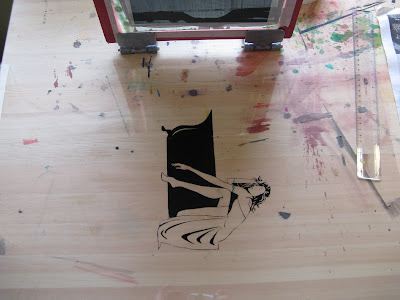Before you begin, make sure you set up all your equipment. You don't want to be scrambling around in the midst of printing. Also be sure to have an area clear for your wet prints to dry. A drying rack works well.
Attach your hinge clamps to the table or a large piece of wood. Tape one side of the large acetate sheet down to the table.

Check your screen for any holes where ink might leak through, and patch them with masking tape. You can also use screen filler if you want, which you can buy at the art store.

Clamp your screen. Prop up the corner with a roll of masking tape and spoon a line of ink onto the bottom of the screen. With your squeegee, push the ink to the top of the screen. This is called "flooding". You need to flood after each print you pull because it prevents the ink from drying out and gunking up your screen.




Now pull a print! Using your sqeegee, apply firm even pressure as you pull towards yourself. You want to print the image onto the acetate first and use it as a guide for all future prints.

Arrange your paper or shirt under the acetate and line up the image where you want it to be. Then flip up the acetate, lower the screen and pull the print. I usually go over it twice. Definitely do a few practice runs on scrap paper first. Add more ink when you need to. You’ll get a feel for it after some practice. Here's a video of me doing it to give you an idea of speed and pressure and all that stuff.
As soon as you’re done printing, use the spatula to scoop up the excess ink from the screen and put it back in the jar. The get to cleaning the screen! You do not want to let the ink dry in the screen. Warm water is ok, but hot could still damage the emulsion if it’s fresh. Hold the screen up to the light to be absolutely sure the stencil is completely clear.
 Don't forget to clean off the acetate so you can reuse it. Just water will do the trick!
Don't forget to clean off the acetate so you can reuse it. Just water will do the trick!

Now repeat this process for the other layer(s) of your design.
And here are a few more random footnotes:
- If you've printed onto fabric, you need to iron the image. If you don't it could fade in the wash.
- In terms of sufaces to print onto... different surfaces may require different amounts of pressure, or more or less pulls with the sqeegee. For example, if you're using glossy paper, you need less pressure, because too much will cause the ink to bleed. You have to experiment a lot. Generally speaking, I'd say more absorbant surfaces are easier to work on.
If you're pulling lots of prints, your screen can dry out after a while. This is where the squirt bottle can help you out. Using a few squirts and a sponge you can gently clear any parts of your screen that are getting blocked by drying paint. Then pull a few prints on scrap paper until the consistency is good again.
I usually keep my screens permanently. But if you want to wash it out, do it ASAP. The emmulsion is really difficult to remove and if you wait more than a couple days, it's pretty much impossible. You have to use the special emulsion remover I mentioned in the materials list.
If you're using the same screen to do multiple colours, sometimes the squirt bottle trick will be enough to clean the screen and start the next colour. But if you need to rinse the screen in the sink, you can speed up the drying process a lot with the use of a hair dryer.
If you need to, you can touch up your prints with a paint brush.






















 Don't forget to clean off the acetate so you can reuse it. Just water will do the trick!
Don't forget to clean off the acetate so you can reuse it. Just water will do the trick!














